Water quality is an important issue in Iowa. At the Iowa Agriculture Water Alliance (IAWA), our goal is to increase farmer-led conservation efforts. Together with landowners, partner organizations, and the private sector, we are doing just that. Learn more about five water quality initiatives that are playing a major role in improved water quality across the state.
1. The watershed-based approach is being used successfully across the state to address water quality challenges.
A collaborative watershed-based approach enables farmers and other stakeholders to target conservation practices where they will be most effective. It makes the best use of taxpayer dollars to design efforts that meet local needs while improving water quality in accordance with the goals of the statewide Iowa Nutrient Reduction Strategy (NRS).
IAWA and our partners have found the following critical success factors are necessary to successfully implement the watershed approach.
- Watershed Planning
- Technical Assistance
- Financial Assistance
- Engagement (local farmer leaders, agribusinesses, and community leaders)
- Trust
Together, they lead to meaningful progress to improve water quality at the watershed scale. Following are examples of this success in two of IAWA’s priority watersheds. The Miller Creek Water Quality Improvement Project (WQI) had 6,355 acres of cover crops in 2018. This is estimated to be 17% of all the row crop acres in the watershed. Farmer demand for cover crops is so high in Miller Creek, the local WQI project ran out of funding. IAWA partnered with the local project to create the “Miller Creek Challenge.” This campaign brought in $125,000 of additional funding to help implement the watershed approach.
The Headwaters of the North Raccoon River Project had 5,450 acres of cover crops in 2018. This represents nearly 10% of total row crop acres in the watershed. The watershed also leads in edge-of-field practices with 37 bioreactors and saturated buffers constructed or in design at the end of 2018.
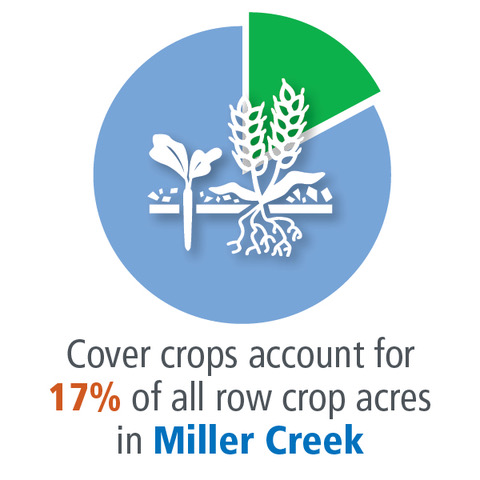

2. The new IAWA Iowa Watershed Awards strengthen the momentum that the watershed approach is building across Iowa.
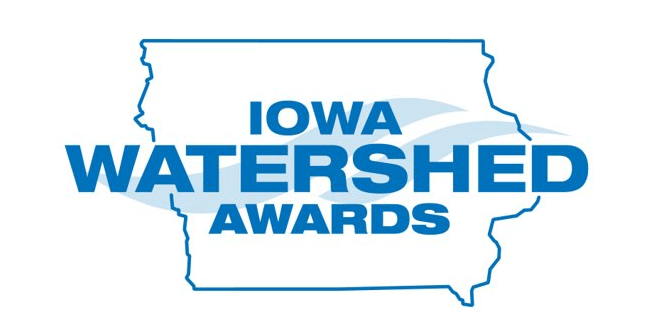
Watershed coordinators, project staff who provide partnership-based management and technical assistance in a watershed, are a key ingredient to the success of locally driven water quality efforts.
To honor watershed coordinators for their contributions and dedication to improving water quality, IAWA — in partnership with Iowa State University (ISU) Extension and Outreach, the Iowa Department of Agriculture and Land Stewardship (IDALS), the Iowa Department of Natural Resources (DNR) and Conservation Districts of Iowa (CDI) — launched the Iowa Watershed Awards program in 2018.
In the inaugural year, we recognized Lee Gravel, watershed coordinator for the Headwaters of the North Raccoon WQI, with the Watershed Coordinator of the Year award. We honored Colton Meyer, the watershed coordinator for the West Branch of the Floyd River WQI, with the 2019 Watershed Coordinator of the Year award.
3. Improving water quality provides opportunities to create jobs and economic development.
There is an opportunity in Iowa to create jobs and economic development opportunities as we scale up conservation practices that improve water quality.
However, there are barriers and missing public and private infrastructure components. These prevent achieving the level of conservation practice adoption that will be necessary in order to successfully implement the Iowa NRS.
For that reason, IAWA and IDALS created the Conservation Infrastructure (CI) initiative to increase the investment and engagement from both the public and private sectors. The CI initiative identifies barriers to scaling up conservation practices and proposes solutions to overcome those barriers. Participants in the initiative are working to accelerate farmer and landowner demand for conservation practices – through outreach, education and training. They are also harnessing economic drivers, innovative market-based solutions, and new revenue streams to improve water quality.
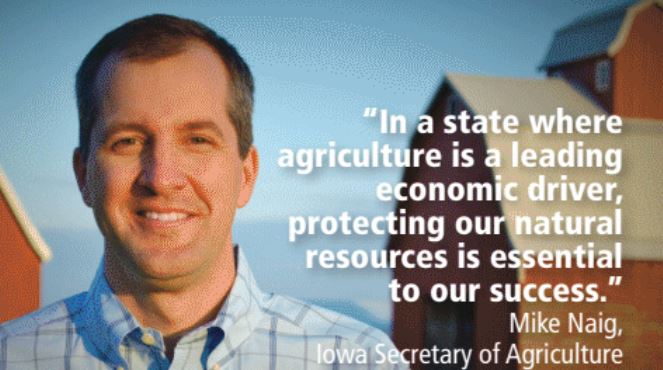
Cover crops provide an example of the barriers we need to overcome and the missing infrastructure that we need. The acreage of cover crops is exponentially increasing from an estimated fewer than 25,000 acres in 2010 to an estimated 1 million acres in 2017.
However, one scenario of the Iowa NRS estimates that we will need 12-17 million acres of cover crops to achieve the nutrient loss reduction goals of the strategy. Currently, there’s not enough cover crop seed produced in all of the U.S. to meet Iowa’s anticipated need.
This creates the following opportunities:
- More cover crops seed production businesses (an estimated 300,000 acres of seed production.)
- New seed cleaning businesses
- More channel partners to distribute cover crops seed
- Additional custom applicators for cover crops
- Supplementary equipment to apply cover crops (drills, aerial, and high clearance)
Opportunities such as this are attracting more private sector investment. However, much more is needed to strengthen the CI initiative and to successfully implement the Iowa NRS.
For a comprehensive list of barriers and proposed solutions to scale up conservation practices and improve Iowa’s water quality, please review the CI Action Plan at www.IowaCI.org.
4. Public-private partnerships are key to improving water quality.
IAWA has worked to bring many private partners to the table to increase efforts to improve water quality in priority watersheds.
The Midwest Agriculture Water Quality Partnership (MAWQP) Regional Conservation Partnership Program (RCPP) is a great example of a public-private partnership to improve water quality.
IAWA co-leads the RCPP with IDALS. NRCS has provided $11M to the MAWQP RCPP program. IAWA and IDALS have leveraged these funds to secure nearly $39M in non-federal match.
It was the largest RCPP in the nation in 2016 when it was approved. In FY18, it was the largest of eight Iowa RCPP projects.
Data for FY 2018

Through the active engagement of the IAWA Business Council, the 5-year, $50M project is on track to be completed in less than three years.
The program is far ahead of schedule on several key milestones. Over 90% of the Environmental Quality Incentives Program (EQIP) dollars for the RCPP have been obligated. To date, the strongest demand for EQIP dollars has been for cost-share for cover crops.
The project has resulted in over 2.5M acres of improved fertilizer management and more than 425,000 acres of cover crops that have been applied or planned through a combination of EQIP funding and partner programs.
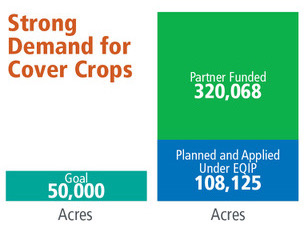
5. Farmer leaders, who are sharing their experience with others, are helping increase the pace and scale of conservation efforts.
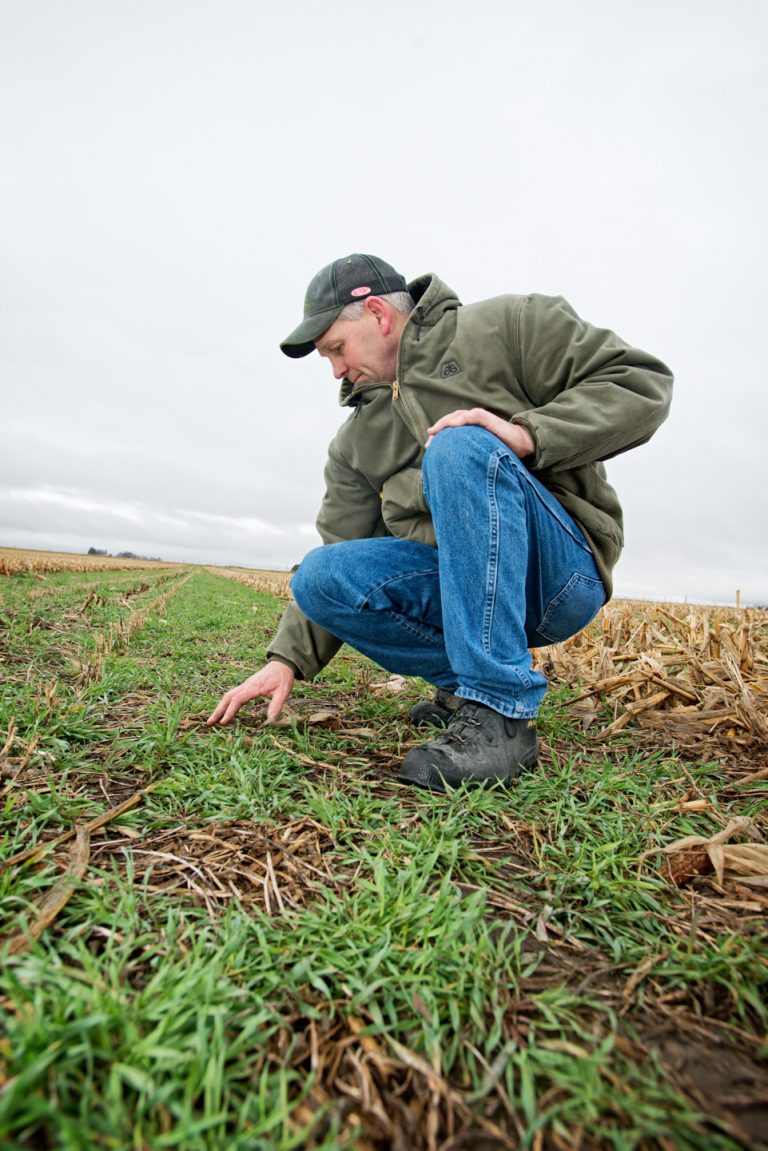 Dean Sponheim, Nora Springs, Iowa, is seeing businesses crop up around conservation practices in his watershed. Through his custom conservation business, Sponheim Sales and Services, he coordinates cereal rye seed production to meet the growing demand for cover crops. He also provides custom strip-tilling. Dean is now seeing some of his customers buy their own machines to start their own businesses.
Dean Sponheim, Nora Springs, Iowa, is seeing businesses crop up around conservation practices in his watershed. Through his custom conservation business, Sponheim Sales and Services, he coordinates cereal rye seed production to meet the growing demand for cover crops. He also provides custom strip-tilling. Dean is now seeing some of his customers buy their own machines to start their own businesses.
These farmer leaders are also implementing new innovative edge-of-field practices such as bioreactors and saturated buffers.
Learn More About Our Water Quality Solutions
These are just five of the efforts IAWA and our partners have in place to improve water quality in Iowa. Many more initiatives are underway. Learn more about the water quality solutions that IAWA and our partners are implementing.
